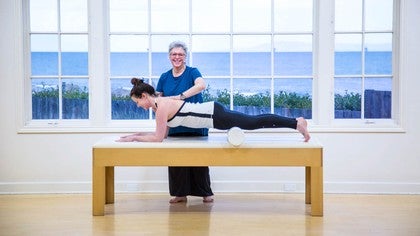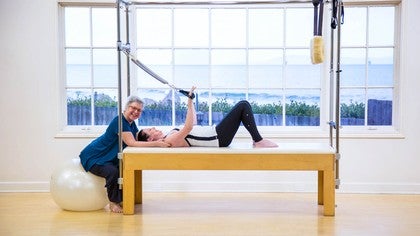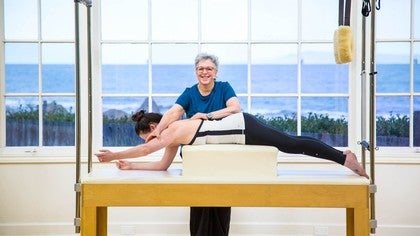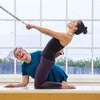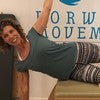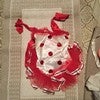Description
About This Video
Transcript
Read Full Transcript
So we're going to talk about the anterior serratus. If you go back to the bone rhythms, we've been talking a lot about upward rotation and we're going to talk about the physicality that will invite that upward rotation. The n teary serratus attaches to the medial border of the shoulder blade and then there's like nine little slow, I call them slices. Um, there they go to each rib, nine ribs. So they're kind of, they're like a hand wrapping around the shoulder, the rib cage. So when you get good function of that, uh, the anterior Serratus, it will bring the shoulder blade around the ribs. And then also once you get that, then these ribs will get flush against the shoulder blade. A lot of times what you see is people are pulling down and in many ways that point down is kicking out the serratus.
So my image is, remember we've been talking about Irma guards had scapular relationship so that if I wanted to pick up this object, I would be wrapping my fingers around and then I would be bringing it up to space. A lot of what we're doing with our shoulder blades is we're locking it behind the torso. There's no way you can lift the, if you try to lift this guy up, you're going to have to go to your neck muscles or other different functions. So we're going to really look at how to start bringing in better serratus connection, which is also going to help solve a lot of your hyperextension of your ribs. So we're gonna do an anterior serratus training. I love this exercise. You start on the forearms, it's really great. Also, if you have clients with risk problems to start training that, and a lot of times the problems of the risks is they don't have good enough to radius connection and all the weight is falling into the wrist.
So it's a great exercise to teach. As well as, this is how I usually start teaching everyone. Then I bring them into, you know, elephant chest rowing front. He can't cheat on this exercise. So Aaron's gonna lie prone and she wants to get the foam roll in like the middle of the thigh bones. Little more. That's it. Then we want to get her l. She has a very wide shoulder girdle, but you also want to make sure that you see my elbows out.
That's internal rotation. So we want, you're going to come a little bit, little narrow, just tiny. But there we go. And then I'm just gonna tell her here and remember it's really light that that's that little external rotation we want her to have. Now remember I'm doing a drawing. So this right where her little top is, that's kind of our first rib. And a lot of times when you see people try to get into Serita's work, they just start working from the bottom.
But you really under realize that the Serita's attaches to the first rib, second rib, third, fourth, fifth, six, seven, eight, nine. So we want to have equal opportunities to radius. So here we go. We're going to let her eyes, sternum drop in New York. We call this schlumpy. There we go. Then I want her to drive her four arms down and I want her to lift her first rib as much. He still little bit too much there. There we did. That was great.
And then sternum drop and what I'm looking for as she presses up that that shoulder blade is rapping and then she gets so lifted. All those rib circles are equally coming up. Now she's doing a pretty good job, but sometimes you feel your clients, they're kind of pulling their armpits down. So this, she's going to make a fist and you might, you're not going to put my hands here and she's going to drive her four arms down to the, to the floor and a little bit forward. Try to kick out the lats sternum drop. She's gonna lightly push and widen and lift up her first rib as much as her.
There we go. That was great. Remember, uh, as we do this simple cereus go ahead. Do it one more time. This is, this is plank pose. We're not really using the lot too much. If I was having to go into downward dog pressing back, yes, there'll be some lat work, but it does not center the humorous bone in the socket. Then the next version she's going to do is I want her to keep that serratus connection and if you put your fingertips towards her ribs, drive your forearms down. Now here's the hard part. I want to feel it says if that's her radius, hugs her. If I feel her arm pit come down, that's telling me that's lat. So I want to cerate his hug.
There we go. Place your hands flat and can she lift her elbows up without losing or upward rotation of her shoulder blades. There you go. Why? Clavicles wider. Clavicles that was great. And then come back down. She's had, she's doing a great job on this left side. She's having problems. And remember when we looked at the bone rhythms, the more I think about my clavicle being wide, it's going to start putting my shoulder girdle in a great place.
Lift your elbow up, keep your clavicle wide, keep your clavicle wide, lift your and she in this way, she's really using her triceps phenomenally. And then she's going to come back down. Now, Aaron, I want you to come to quadriplegic and so we're going to do the same idea. So Ha, there you go. Now Aaron, you just have to think of InDesign. Aaron has very long arms so she's going to be more at a slant. If it's me, I'm more like that cause I have the shortest arms in the world. So here we go.
So now the hardest part about this is sometimes they lose the mobility in the humorous bone. So the shoulder blades are going to come together and slump and then she wants to get the tip of the shoulder blades widening and lifting. And there we go. Great. Shoulderblades come together and slump and then you're going to push off and widen and lift up that clavicle. Why Clavicle? There we go. That's great. So you, she's doing a really good job because you see this part of her spine has a really lovely flection.
So now we're going to take Aaron in downward dog and we're going to look at what she does and then we're going to also then look at how to enhance that. So let's see, even go back to sternum drop. I do this with all my clients. It kind of gets them aware of where their scapula's, where their breastbone is good. And now let's watch her go to downward dog. So do you see her shoulder blades are starting to narrow and, and she's getting hyper extended right through here. So let's have her come back.
So I want to get to that feeling that she had when she was on her forearms and I had her straighten her arms. So in one way in her practice, she's going to feel like she's in a box because I'm not going to let her lose her serratus connection. So she's going to keep that wrap and she's going to lift her knees up a little bit. She's going to keep her ribs flush up against this. She's going to keep the first rib up and she's going to keep all those ribs up and then she's losing. She's going to get those triceps to work. Thank you so much. There you go.
So then if Aaron pushed harder, she's going to link there. So right now we're still need to get better work of that shoulder blade cause she's extending through her thoracic. So Erin's going to come down and I am the pro and bad version and good version. So come on off and let me show you. So I'm going to do first good version.
So do you see how my shoulder blade is wide? And then when I push up my shoulder blades are wide and when I push more I get length in my spine. I'm going to let my shoulder blades go. So do you see them hyper extended? And then when I push it just goes into more thoracic extension. So that's where we're gonna keep working on finding that because once you get that coordination, it's going to change your back and it's also going to connect you to the core differently. Okay. So Erin, I'm going to have her come back.
Sometimes my clients love my bad version and they understand visually what I'm talking about. So I'm also going to get that tone coming through here and we'll talk a little bit in the next tutorial about the tricep. But we want to get those shoulders, sternum drop. She's going to push off and widen. I want her to visualize those shoulderblades wrapping to her breastbone, vivid imagination. She's going to lift her knees up, she going to good, and she's going to go back and I want her to imagine she's lifting those ribs up to the ceiling and she started, this is where she starts losing it.
So I'm getting her to feel that serratus tone and that's great. So she, we're going to keep working on that, but that is starting to give her her natural flection when she has that serratus connection. Wonderful. Nice. Thank you so much.
Embodied Anatomy: Upper Body
Comments
The anatomy of the SA would indicate that the upper part of the SA (upper 4 slips) is best suited for scapular abduction or protraction movements. The lower part of the SA seems to be more suited for upward rotation of the scapula. The results of this study corroborate this premise. The 3 muscle tests, where upward rotation of the scapula was primarily resisted, were those that produced significantly greater EMG activity in the lower part of the SA as compared to the upper part.
https://www.jospt.org/doi/pdf/10.2519/jospt.2004.34.5.235
You need to be a subscriber to post a comment.
Please Log In or Create an Account to start your free trial.
